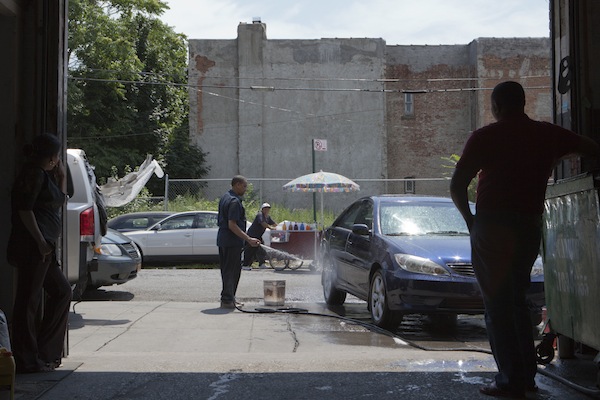
Photo by: Marc Fader
Workers near the former Wolff-Alport chemical factory near the Brooklyn-Queens border. A series of studies have found varying degrees of radioactive contamination. Whatever the risk, employees we spoke to on or near the site in 2012 were mostly unaware of the site’s history.
The Environmental Protection Agency has proposed putting a site on the Brooklyn-Queens border on the Superfund list, a national registry of contaminated properties slated for comprehensive clean-up partly funded—where possible—by the companies who tainted them.
The former Wolff-Alpert site at 1139 Irving Avenue in Ridgewood is mere feet from the Bushwick border. It was the focus of a 2012 City Limits investigation of city and state brownfields programs.
The EPA will take public comment on the proposal for 60 days and then render a final decision. If the Irving Avenue site is approved for inclusion on the list, it would be the 87th Superfund site in the state—the third-largest roster in the country. It would also join Brooklyn’s Newtown Creek and the Gowanus Canal as an active Superfund site in New York City.
Wolff-Alpert was a chemical company that imported monazite sand from the Belgian Congo in the 1940s. The sand contained thorium, which is radiaoactive and can have “serious health effects” according to regional administrator Judith Enck of the EPA. At first, the company flushed the excess sand into the sewer system, but in 1947 federal regulators made them stop and instead truck the contaminants off-site. But the contamination remained.
The company is long gone, but buildings remain on the site, and alarms have been raised about the exposure people get there. In 2007 the city’s health department warned workers on site to avoid areas where the radiation was especially president, and two years later the department found that radiation levels in front of the building were 75 times higher than background.
Recently, according to Enck, officials determined that was no immediate health threat anywhere except the Primo AutoBody Shop at 1127 Irving. Other sampling found problems in a few places nearby, including PS 384, located two blocks away. The school sealed a hole in the basement floor that was the source of the exposure.
As Brooklyn Bureau’s Jake Mooney reported last year, the Wolff-Alpert site:
is one of hundreds of brownfields – underused former industrial sites with varying levels of contamination – taking up more than 7,000 acres of land in the five boroughs. Mayor Bloomberg’s office calls remediating brownfields a top priority, and several government initiatives, including a state brownfield cleanup program launched in 2003 and a city version started in 2010, aim to help.
…
Progress, however, is slow. For every site entered in one of the various cleanup programs – as of June, 39 of them in the city had completed the state’s program, and 54 more were going through investigation or remediation – many more are stagnant.
Comments on the proposal can be made here.








